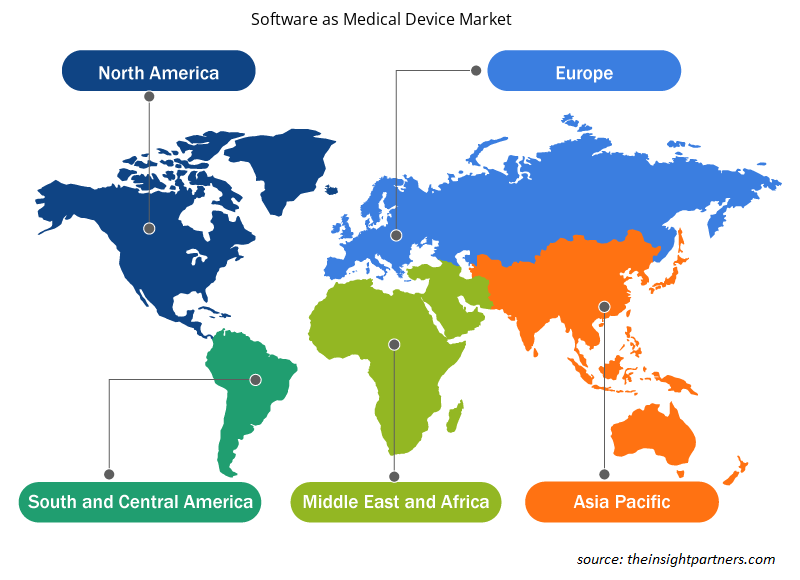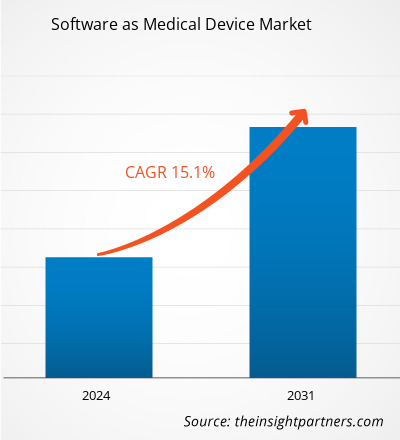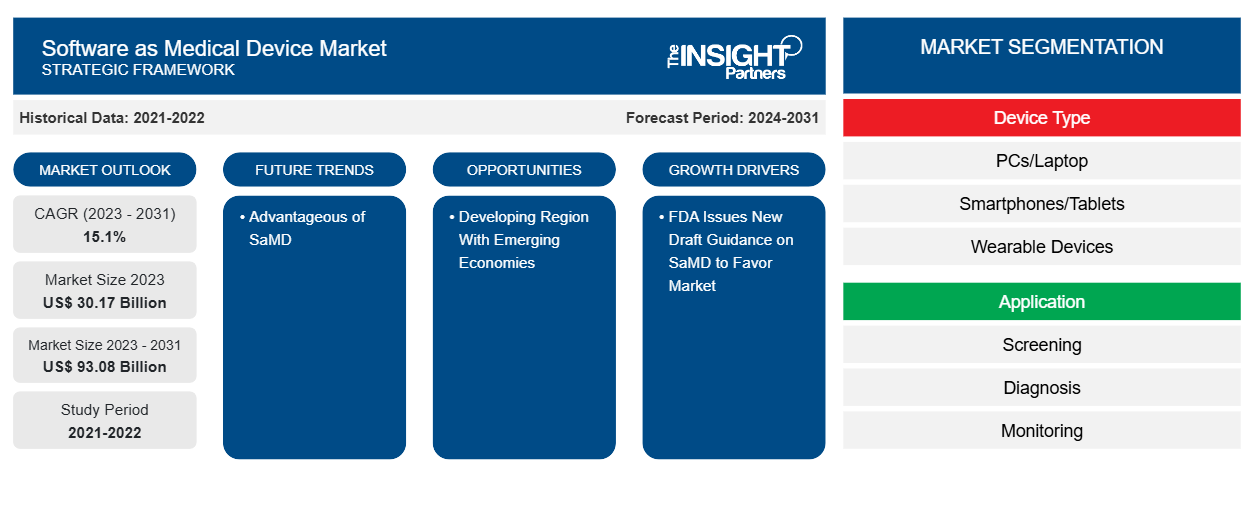Der Markt für Software als Medizinprodukt soll von 30,17 Milliarden US-Dollar im Jahr 2023 auf 93,08 Milliarden US-Dollar im Jahr 2031 anwachsen. Der Markt wird zwischen 2023 und 2031 voraussichtlich eine durchschnittliche jährliche Wachstumsrate von 15,1 % verzeichnen. Die zunehmende Anzahl tragbarer Medizinprodukte dürfte ein wichtiger Trend auf dem Markt bleiben.
Marktanalyse für Software als Medizinprodukt
In den letzten Jahren hat sich Software als Medizinprodukt (SaMD) zu einem wichtigen Instrument im Gesundheitswesen entwickelt, und ihr Wachstum dürfte sich im Jahr 2023 beschleunigen. Faktoren wie SaMD und andere digitale Lösungen verändern die Interaktion zwischen Patient und Arzt und offenbaren die Macht der gemeinsamen Nutzung, Sammlung und Nachverfolgung von Daten. Andere Faktoren wie die zunehmende Verbreitung von Virtual First Care oder V1C stehen im Vordergrund und ermöglichen es Gesundheitsdienstleistern, Pflege zu leisten, ohne einen physischen Kontakt zu riskieren. Dadurch werden Krankheiten, die aus der Ferne übertragen werden, beherrschbar.
Marktübersicht zu Software als Medizinprodukt
Mexiko konzentriert sich darauf, die Digitalisierung des Gesundheitswesens voranzutreiben, indem es die Integration softwarebasierter digitaler Lösungen in seine Infrastruktur fördert. Das Land wächst mit beispielloser Geschwindigkeit. In den letzten Jahrzehnten hat die mexikanische Regierung eine ehrgeizige Initiative gestartet, um die allgemeine Qualität der Gesundheitsversorgung durch die Implementierung digitaler Tools in ihren Gesundheitseinrichtungen zu verbessern. Die Entwicklung der digitalen Gesundheitsversorgung im Land wird wahrscheinlich auch das Wachstum des Marktes fördern und in den kommenden Jahren ein förderliches Szenario bieten. Darüber hinaus wird der Anteil der geriatrischen Bevölkerung Mexikos ab 60 Jahren von 6,3 % im Jahr 2010 auf 23 % im Jahr 2050 steigen. Daher wird erwartet, dass Faktoren wie die steigende geriatrische Bevölkerung die Nachfrage im kommenden Jahrzehnt erhöhen werden.
Passen Sie diesen Bericht Ihren Anforderungen an
Sie erhalten kostenlos individuelle Anpassungen an jedem Bericht, einschließlich Teilen dieses Berichts oder einer Analyse auf Länderebene, eines Excel-Datenpakets sowie tolle Angebote und Rabatte für Start-ups und Universitäten.
-
Holen Sie sich die wichtigsten Markttrends aus diesem Bericht.Dieses KOSTENLOSE Beispiel umfasst eine Datenanalyse von Markttrends bis hin zu Schätzungen und Prognosen.
Software als Treiber und Chancen auf dem Markt für medizinische Geräte
FDA veröffentlicht neuen Leitlinienentwurf zu SaMD zur Marktförderung
Ein kürzlich veröffentlichter aktualisierter Leitfadenentwurf klärt und rationalisiert den Prozess. Dem neuen Leitfaden zufolge wurde die Software als Medizinprodukt sowohl für Patienten als auch für Pflegepersonal in Clinical Decision Support Software (CDSS) und Patient Decision Support Software (PDS) eingeteilt. Diese Klassifizierungsregeln berücksichtigen mehrere Faktoren, darunter den Grad der Invasivität im Körper, die Dauer des Kontakts, das betroffene Körpersystem und lokale versus systemische Auswirkungen. Der aktualisierte Leitfadenentwurf ist auch ein Hinweis auf eine verstärkte Entwicklung von SaMD.
Entwicklungsregionen mit Schwellenländern
Mit dem Wachstum der Wirtschaft und des Pro-Kopf-Einkommens der Menschen in den Schwellenländern steigt auch das Wachstum für verbesserte medizinische Dienstleistungen. Das Wachstum der medizinischen Industrie ist auf die zunehmende Automatisierung der Gesundheitsdienstleistungen zurückzuführen . Die globalen Marktteilnehmer ziehen die Region für ihre Geschäftsexpansion in den Schwellenländern in Betracht, was im Prognosezeitraum voraussichtlich zu einem weiteren Wachstum des Marktes für Software als Medizinprodukt (SaMD) führen wird. Nach Schätzungen der Communications and Information Technology Commission (CITC) des Königreichs nutzen die meisten (54 %) saudischen Verbraucher Technologie, um ihre Gesundheit zu verwalten, 40 % verwenden Gesundheits-Apps auf Mobilgeräten und die restlichen 14 % verwenden tragbare Technologie.
Marktsegmentierungsanalyse für Software als Medizinprodukt
Wichtige Segmente, die zur Ableitung der Marktanalyse für Software als medizinisches Gerät beigetragen haben, sind Gerätetyp, Anwendung und Bereitstellungstyp.
- Basierend auf dem Gerätetyp ist der Markt für Software als medizinisches Gerät in PCs/Laptops, Smartphones/Tablets und tragbare Geräte unterteilt. Das PCs/Laptop-Segment hatte im Jahr 2023 einen größeren Marktanteil.
- Nach Anwendung ist der Markt in Screening und Diagnose, Überwachung und Alarmierung sowie Krankheitsmanagement unterteilt. Das Segment Screening und Diagnostik hatte im Jahr 2023 den größten Marktanteil.
- In Bezug auf die Bereitstellungsart ist der Markt in Cloud und On-Premises unterteilt. Das Cloud-Segment hatte im Jahr 2023 den größten Marktanteil.
Software als Medizinprodukt – Marktanteilsanalyse nach geografischer Lage
Der geografische Umfang des Marktberichts „Software als medizinisches Gerät“ ist hauptsächlich in fünf Regionen unterteilt: Nordamerika, Asien-Pazifik, Europa, Naher Osten und Afrika sowie Süd- und Mittelamerika.
Nordamerika dominiert den Markt. Die Verbreitung von künstlicher Intelligenz, maschinellem Lernen, natürlicher Sprachverarbeitung (NLP) und deren Anwendung in der digitalen Gesundheitsfürsorge dürfte für die Dominanz des Marktes verantwortlich sein. Darüber hinaus sorgen die neuen Lösungen für die Diagnose und Fernüberwachung von Patienten durch Smartphone- und Laptop-basierte Softwarelösungen von wichtigen Marktführern für eine steigende Nachfrage nach diesen Lösungen, da sie einfach zu bedienen, zu verstehen und Gesundheitszustände zu analysieren sind und somit ihre Nachfrage steigern. Der asiatisch-pazifische Raum wird in den kommenden Jahren voraussichtlich die höchste durchschnittliche jährliche Wachstumsrate aufweisen.
Regionale Einblicke in den Markt für Software als Medizinprodukt
Die regionalen Trends und Faktoren, die den Markt für Software als Medizinprodukt im Prognosezeitraum beeinflussen, wurden von den Analysten von Insight Partners ausführlich erläutert. In diesem Abschnitt werden auch Marktsegmente und Geografien für Software als Medizinprodukt in Nordamerika, Europa, im asiatisch-pazifischen Raum, im Nahen Osten und Afrika sowie in Süd- und Mittelamerika erörtert.

- Erhalten Sie regionale Daten zum Markt für Software als Medizinprodukt
Umfang des Marktberichts über Software als Medizinprodukt
| Berichtsattribut | Details |
|---|---|
| Marktgröße im Jahr 2023 | 30,17 Milliarden US-Dollar |
| Marktgröße bis 2031 | 93,08 Milliarden US-Dollar |
| Globale CAGR (2023 - 2031) | 15,1 % |
| Historische Daten | 2021-2022 |
| Prognosezeitraum | 2024–2031 |
| Abgedeckte Segmente |
Nach Gerätetyp
|
| Abgedeckte Regionen und Länder |
Nordamerika
|
| Marktführer und wichtige Unternehmensprofile |
|
Marktteilnehmerdichte: Der Einfluss auf die Geschäftsdynamik
Der Markt für Software als Medizinprodukt wächst rasant. Dies wird durch die steigende Nachfrage der Endnutzer aufgrund von Faktoren wie sich entwickelnden Verbraucherpräferenzen, technologischen Fortschritten und einem größeren Bewusstsein für die Vorteile des Produkts vorangetrieben. Mit der steigenden Nachfrage erweitern Unternehmen ihr Angebot, entwickeln Innovationen, um die Bedürfnisse der Verbraucher zu erfüllen, und nutzen neue Trends, was das Marktwachstum weiter ankurbelt.
Die Marktteilnehmerdichte bezieht sich auf die Verteilung der Firmen oder Unternehmen, die in einem bestimmten Markt oder einer bestimmten Branche tätig sind. Sie gibt an, wie viele Wettbewerber (Marktteilnehmer) in einem bestimmten Marktraum im Verhältnis zu seiner Größe oder seinem gesamten Marktwert präsent sind.
Die wichtigsten Unternehmen auf dem Markt für Software als Medizinprodukt sind:
- Velentium LLC
- Tietronix Software, Inc.
- S3 Vernetzte Gesundheit
- Zühlke Gruppe
- Wissenschaftsgruppe
- Inzentiz
Haftungsausschluss : Die oben aufgeführten Unternehmen sind nicht in einer bestimmten Reihenfolge aufgeführt.

- Überblick über die wichtigsten Akteure auf dem Markt für Software als medizinisches Gerät
Neuigkeiten und aktuelle Entwicklungen zum Markt für Software als Medizinprodukt
Der Markt für Software als Medizinprodukt wird durch die Erhebung qualitativer und quantitativer Daten nach Primär- und Sekundärforschung bewertet, die wichtige Unternehmensveröffentlichungen, Verbandsdaten und Datenbanken umfasst. Nachfolgend sind einige der Entwicklungen auf dem Markt für Software als Medizinprodukt aufgeführt:
- CompliancePath und Ideagen sind eine Produktvalidierungspartnerschaft eingegangen, um ihr laufendes Validierungsbeschleunigungsprogramm auf alle Life-Science-bezogenen Softwareprodukte auszuweiten. (Quelle: CompliancePath, Pressemitteilung, April 2020)
- Das in den USA ansässige Unternehmen STAT Health hat ein rund um die Uhr tragbares Im-Ohr-Produkt für das allgemeine Wohlbefinden vorgestellt, das den Blutfluss misst. (Quelle: STAT Health, Pressemitteilung, Juni 2023)
Marktbericht zu Software als Medizinprodukt – Umfang und Ergebnisse
Der Bericht „Marktgröße und Prognose für Software als Medizinprodukt (2021–2031)“ bietet eine detaillierte Analyse des Marktes, die die folgenden Bereiche abdeckt:
- Marktgröße und Prognose für Software als Medizinprodukt auf globaler, regionaler und Länderebene für alle wichtigen Marktsegmente, die im Rahmen des Berichts abgedeckt sind
- Markttrends und Marktdynamiken für Software als Medizinprodukt, darunter Treiber, Einschränkungen und wichtige Chancen
- Detaillierte PEST/Porters Five Forces- und SWOT-Analyse
- Marktanalyse für Software als Medizinprodukt, die wichtige Markttrends, globale und regionale Rahmenbedingungen, wichtige Akteure, Vorschriften und aktuelle Marktentwicklungen umfasst
- Branchenlandschaft und Wettbewerbsanalyse, die die Marktkonzentration, Heatmap-Analyse, prominente Akteure und aktuelle Entwicklungen für den Markt für Software als Medizinprodukt umfasst
- Detaillierte Firmenprofile
- Historische Analyse (2 Jahre), Basisjahr, Prognose (7 Jahre) mit CAGR
- PEST- und SWOT-Analyse
- Marktgröße Wert/Volumen – Global, Regional, Land
- Branchen- und Wettbewerbslandschaft
- Excel-Datensatz
Aktuelle Berichte
Verwandte Berichte
Erfahrungsberichte
Grund zum Kauf
- Fundierte Entscheidungsfindung
- Marktdynamik verstehen
- Wettbewerbsanalyse
- Kundeneinblicke
- Marktprognosen
- Risikominimierung
- Strategische Planung
- Investitionsbegründung
- Identifizierung neuer Märkte
- Verbesserung von Marketingstrategien
- Steigerung der Betriebseffizienz
- Anpassung an regulatorische Trends























 Kostenlose Probe anfordern für - Markt für Software als Medizinprodukt
Kostenlose Probe anfordern für - Markt für Software als Medizinprodukt